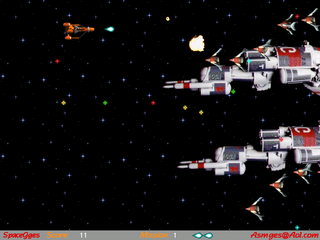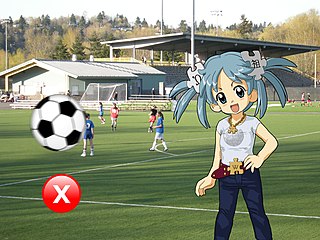Real-time strategy (RTS) is a subgenre of strategy video games that doesn't progress incrementally in turns, but allow all players to play simultaneously, in "real time". By contrast, in turn-based strategy (TBS) games, players take turns to play. The term "real-time strategy" was coined by Brett Sperry to market Dune II in the early 1990s.
A multiplayer video game is a video game in which more than one person can play in the same game environment at the same time, either locally on the same computing system, on different computing systems via a local area network, or via a wide area network, most commonly the Internet. Multiplayer games usually require players to share a single game system or use networking technology to play together over a greater distance; players may compete against one or more human contestants, work cooperatively with a human partner to achieve a common goal, or supervise other players' activity. Due to multiplayer games allowing players to interact with other individuals, they provide an element of social communication absent from single-player games.
An action game is a video game genre that emphasizes physical challenges, including hand–eye coordination and reaction time. The genre includes a large variety of sub-genres, such as fighting games, beat 'em ups, shooter games, and platform games. Multiplayer online battle arena and some real-time strategy games are also considered action games.

A video game genre is an informal classification of a video game based on how it is played rather than visual or narrative elements. This is independent of setting, unlike works of fiction that are expressed through other media, such as films or books. For example, a shooter game is still a shooter game, regardless of where or when it takes place. A specific game's genre is open to subjective interpretation. An individual game may belong to several genres at once.
Shooter video games or shooters are a subgenre of action video games where the focus is almost entirely on the defeat of the character's enemies using the weapons given to the player. Usually these weapons are firearms or some other long-range weapons, and can be used in combination with other tools such as grenades for indirect offense, armor for additional defense, or accessories such as telescopic sights to modify the behavior of the weapons. A common resource found in many shooter games is ammunition, armor or health, or upgrades which augment the player character's weapons.
Micromanagement in gaming is the handling of detailed gameplay elements by the player. It appears in a wide range of games and genres, including strategy video games, construction and management simulations, and pet-raising simulations. Micromanagement has been perceived in different ways by game designers and players for many years: some perceive it as a useful addition to games that adds options and technique to the gameplay, something that is necessary if the game is to support top-level competitions; some enjoy opportunities to use tactical skill in strategic games; others regard it as an unwelcome distraction from higher levels of strategic thinking and dislike having to do a lot of detailed work. Some developers attempt to minimize micromanagement in a game's interface for this reason.
In tabletop games and video games, game mechanics are the rules or ludemes that govern and guide the player's actions, as well as the game's response to them. A rule is an instruction on how to play, a ludeme is an element of play like the L-shaped move of the knight in chess. A game's mechanics thus effectively specify how the game will work for the people who play it.
The following outline is provided as an overview of and topical guide to video games:
An interactive film is a video game or other interactive media that has characteristics of a cinematic film. In the video game industry, the term refers to a movie game, a video game that presents its gameplay in a cinematic, scripted manner, often through the use of full-motion video of either animated or live-action footage.
Turn-based tactics (TBT) is a video game genre of strategy video games. They are turn-based simulations of operational warfare and military tactics in generally small-scale confrontations as opposed to more strategic considerations of turn-based strategy (TBS) games. Turn-based tactical gameplay is characterized by the expectation of players to complete their tasks using only the combat forces provided to them in a generally realistic manner.
Real-time tactics (RTT) is a subgenre of tactical wargames played in real-time, simulating the considerations and circumstances of operational warfare and military tactics. It is differentiated from real-time strategy gameplay by the lack of classic resource micromanagement and base or unit building, as well as the greater importance of individual units and a focus on complex battlefield tactics.
A healer is a type of character class in video gaming. When a game includes a health game mechanic and multiple classes, often one of the classes will be designed around the restoration of allies' health, known as healing, in order to delay or prevent their defeat. Such a class can be referred to as a healer. In addition to healing, healer classes are sometimes associated with buffs to assist allies in other ways, and nukes to contribute to the offense when healing is unnecessary.

In video games, a quick time event (QTE) is a method of context-sensitive gameplay in which the player performs actions on the control device shortly after the appearance of an on-screen instruction/prompt. It allows for limited control of the game character during cut scenes or cinematic sequences in the game. Performing the wrong prompt, mistiming the action, or not performing any action at all results in the character's failure at their task, resulting in a death/failure animation and often an immediate game over or the loss of a life, with some games providing a lesser but significant penalty of sorts instead.
Tower defense (TD) is a subgenre of strategy games where the goal is to defend a player's territories or possessions by obstructing the enemy attackers or by stopping enemies from reaching the exits, usually achieved by placing defensive structures on or along their path of attack. This typically means building a variety of different structures that serve to automatically block, impede, attack or destroy enemies. Tower defense is seen as a subgenre of real-time strategy video games, due to its real-time origins, even though many modern tower defense games include aspects of turn-based strategy. Strategic choice and positioning of defensive elements is an essential strategy of the genre.
Strategy is a major video game genre that emphasizes thinking and planning over direct instant action in order to achieve victory. Although many types of video games can contain strategic elements, as a genre, strategy games are most commonly defined as those with a primary focus on high-level strategy, logistics and resource management. They are also usually divided into two main sub-categories: turn-based and real-time, but there are also many strategy cross/sub-genres that feature additional elements such as tactics, diplomacy, economics and exploration.
Nonviolent video games are video games characterized by little or no violence. As the term is vague, game designers, developers, and marketers that describe themselves as non-violent video game makers, as well as certain reviewers and members of the non-violent gaming community, often employ it to describe games with comparatively little or no violence. The definition has been applied flexibly to games in such purposive genres as the Christian video game. However, a number of games at the fringe of the "non-violence" label can only be viewed as objectively violent.

Survival games are a subgenre of video games which are usually set in hostile, intense, open-world environments. Players generally start with minimal equipment and are required to survive as long as possible by crafting tools, weapons, shelters, and collecting resources. Many survival games are based on randomly or procedurally generated persistent environments; more recently, survival games are often playable online, allowing players to interact in a single world. Survival games are generally open-ended with no set goals and often closely related to the survival horror genre, where the player must survive within a supernatural setting, such as a zombie apocalypse.

A first-person shooter (FPS) is a video game centered on gun fighting and other weapon-based combat seen from a first-person perspective, with the player experiencing the action directly through the eyes of the main character. This genre shares multiple common traits with other shooter games, and in turn falls under the action games category. Since the genre's inception, advanced 3D and pseudo-3D graphics have proven fundamental to allow a reasonable level of immersion in the game world, and this type of games helped pushing technology progressively further, challenging hardware developers worldwide to introduce numerous innovations in the field of graphics processing units. Multiplayer gaming has been an integral part of the experience, and became even more prominent with the diffusion of internet connectivity in recent years.
This list includes terms used in video games and the video game industry, as well as slang used by players.




